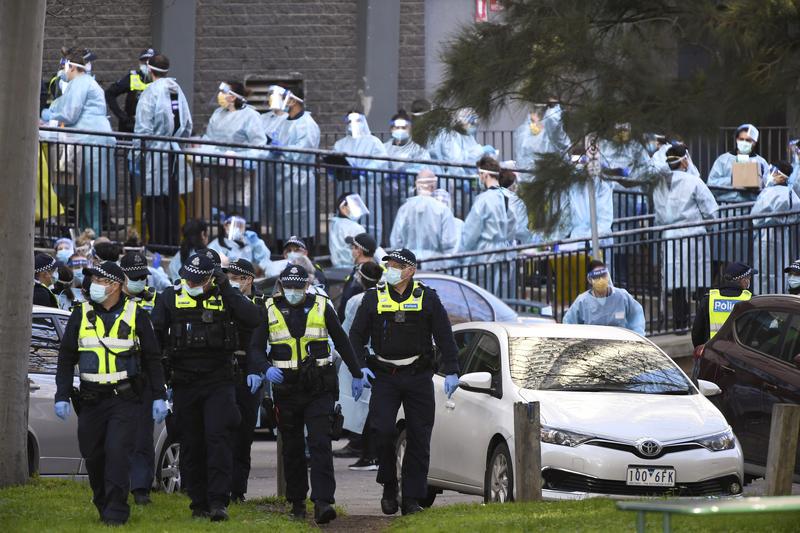 Police officers and healthcare workers are stationed outside a public housing tower that is locked down as a Coronavirus hotspot in Melbourne, Australia, July 8, 2020. (JAMES ROSS / AAP IMAGE VIA AP)
Police officers and healthcare workers are stationed outside a public housing tower that is locked down as a Coronavirus hotspot in Melbourne, Australia, July 8, 2020. (JAMES ROSS / AAP IMAGE VIA AP)
Police and military have thrown a ring of steel around the metropolitan area of Melbourne, Australia’s second most populous city, in a bid to halt the spread of the COVID-19 virus which has intensified since restrictions were dropped last month.
As of midnight on July 8, five million people in the Victorian capital are being restricted to their homes for the next six weeks as medical teams try to get on top of the virus and stop its spread
As of midnight on July 8, five million people in the Victorian capital are being restricted to their homes for the next six weeks as medical teams try to get on top of the virus and stop its spread.
The Australian treasurer, Josh Frydenberg, told a press briefing on July 8 that the lockdown will cost the national economy about A$1 billion (US$693.5 million) a week.
The state of Victoria is the second-largest economy in Australia, behind New South Wales, according to Reserve Bank of Australia data.
At midnight on July 7 – for the first time since 1919 during the great influenza pandemic – NSW closed its border with Victoria, throwing the lives of thousands in the border city of Albury-Wodonga into chaos. The border divides the city, with Albury located in NSW and Wodonga in Victoria.
Police and military using drones are now patrolling the border, with heavy fines and even potential jail time for those trying to cross without permission.
Those allowed to cross include essential workers and those with passes issued by the NSW government to allow those living in either part of the city to go to work or school, to shop, or seek medical treatment.
The decision to close the border came as a surprise to many living in the city, with workers waiting for hours on either side of the border on July 8 to go to work.
Victoria on July 8 reported 134 new COVID-19 cases overnight, with 75 new cases in nine low-cost housing towers which were closed on July 4. The towers house 3,000 people.
It was the third day in a row that Victoria had recorded more than 100 cases, and 134 was the state’s second-highest single-day total after a record 191 on July 7.
The Victorian premier, Daniel Andrews, told a media briefing on July 8 that more than one million people had been tested for the coronavirus since January, with 29,424 tests conducted on July 7.
Andrews again apologized to Victorians for the lockdown, saying: “We are all working as hard as we can, doing the very best that we can, and we know that we’re asking a lot of Victorians and we know, of course, that we didn’t want to be in the position that we are in. But that’s the reality that we confront.
“This is the challenge that we have to meet, and I think that if we all work together over these next six weeks, as painful and frustrating and difficult as that will be, we will be able to get to the other side of this stay-at-home period.”
An expert in influenza and emerging infectious diseases, Professor Raina MacIntyre, said the situation in Victoria is “extremely serious”.
ALSO READ: Virus: Australia deploys police, army to enforce border closure
“We have seen outbreaks in a wider area over the past week, from northwest Melbourne to inner Melbourne and even at the border town, Albury-Wodonga,” said MacIntyre, head of the biosecurity program at the Kirby Institute, University of New South Wales.
She said the surge in cases over the past week is worrying.
“It is possible there has been seeding of infection to other states, and silent epidemic growth which has not yet been detected. I would not be surprised to see epidemics detected in NSW and other states within the next few weeks.”
She said: “The situation we are in is more serious than late March, because we have community transmission, which is much harder to track than infection in returned travelers.”
Rob Grenfell, biosecurity director of the Commonwealth Scientific and Industrial Research Organisation, the Australian government’s agency responsible for scientific research, said: “The problem we’re facing is that the increase in cases across Melbourne now is the result of what happened about 10 days ago, due to the virus’ long incubation period, and this roughly coincides with when restrictions were lifted.”
He said one could argue “we’re still in the first wave because we’ve protracted it by suppressing the curve through lockdown measures earlier this year”, which “has given us the time to get our health services ready, prepare for increased hospitalizations and intensive care cases”.
READ MORE: Australia to deploy 1,000 troops to Victoria as infections surge
Because of the delay in symptoms and the disease manifesting, it could be another week before the corresponding increase in cases requiring hospitalization were seen.
“As a country, we need to close this down as much as is practically possible so we can reduce the infection across the rest of Australia,” Grenfell said.


